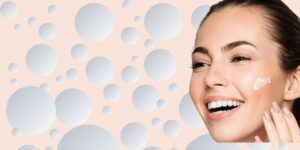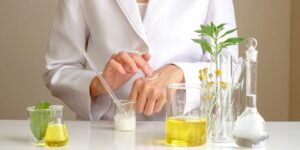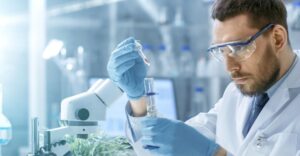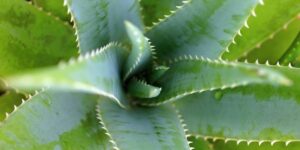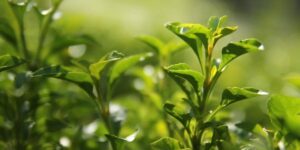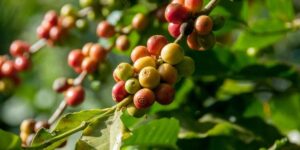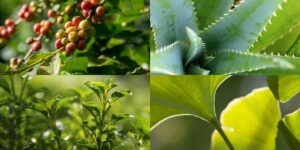Introduction
Botanical extracts are complex solutions of chemical ingredients extracted by various methods from plants known to exhibit some type of skin active effects. The use of plant extracts in skincare dates back thousands of years 1 when they were traditionally used to treat specific skin ailments. The plant kingdom offers an abundant source of substances that offer novel cures for many skin disease types2. Modern chemical extraction, analysis and identification techniques have led scientists to search the earth for new flora species and new active ingredients for skincare. Botanical ingredients are often considered more “natural” than chemical drugs as they come from a “natural” source.
Botanicals incorporated into skin care products are often referred to a cosmeceuticals3. These are defined as intermediary substances between drugs and cosmetics 2 and mostly fall outside the normal regulatory and approval processes of skincare drugs. Consequentially, most botanical substances regularly used in skincare products lack controlled clinical trial testing to assess their real biological effects. Thus it is difficult for formulators to choose which ones truly deliver what they and the manufacturer promise2.
“Botanical ingredients have been used for thousands of years in skincare for their convenience as well as the diversity and abundance in compounds with biological activity.” 1
Factors Affecting Botanical Extract Effectiveness
The actual effectiveness of a given botanical extract, delivered in topical skin application, is determined by a complex array of factors unrelated to the chemical properties of the ingredients. Formulation considerations are far more complex than most dermatologists4 and manufacturers realise. The following is a list of some of the factors that can impact the effectiveness of a botanical extract delivered to the skin in topical application:
Source of the Plant Extract
Different parts of a given plant (leaves, roots etc.) can contain varying concentrations and types of botanically active ingredients. The same plant found in different locations and under different climatic and seasonal conditions can contain different concentrations and types of active ingredients. Thus the efficacy of a given botanical extract can vary with plant source, season, location and from which part of the plant the constituent was extracted4.
Extraction Processing
Botanical extracts are prepared by chemically extracting the active constituents from the plant mass. This processing may involve water, oil, or alcohol-mixture solvent extraction with or without heat. Many active botanical ingredients are heat sensitive (eg. Vitamin C) and heated extraction may cause degradation in active constituents in the final extract. Different extraction solvents used may have different extraction efficiencies for different active constituents. Thus the botanical active concentration in the final extract can vary significantly with the type of extraction process used. This information is rarely provided by botanical extract suppliers. The skincare manufacturer and therefore the product consumer has little knowledge of the concentration of biological actives in any given skincare product and this concentration may vary from batch to batch in the same product.
Extraction Stability
Biologically active plant constituents often have anti-oxidant properties and are stable when contained in a plant biological matrix. However, once extracted into a solvent extract, they lose that protection and can oxidise and degrade in contact with air, water and light. Thus a high plant contained concentration of active ingredients may, with time, translate into a far lower concentration in the botanical extract when added to the formulation.
Formulation Concentration
The ingredient labels of many skincare products claiming botanical extract benefits reveals that some contain a potpourri of botanical extracts. As the total concentration of a product’s ingredients cannot exceed 100% (including a normally high concentration of water) the concentration of individual botanical extracts must be low. The efficacy of most botanical extracts is concentration dependent meaning that there is a concentration point below which the extract becomes less effective. It is obvious that many skincare products contain such low concentrations of biological extracts as to possibly render them ineffective.
Formulation Processing
Many cosmetic creams and lotions require heating during manufacture. Just as heat during the extraction process can degrade biologically active constituents in a botanical extract, heat during production can also degrade these ingredients in the finished product. The concentration of biological actives in the final product may be reduced by the production process itself, leading to lower product efficacy.
Product Stability
Preparation of skincare products requires mixing the ingredients in, typically, a water based mixture. Biological extracts are added to this mixture and become diluted as part of the product formulation matrix. Biologically active plant constituents with anti-oxidant properties (such as Vitamin C) can react with this matrix and cause degradation of the active constituents. Water, air, heat, light and pH can affect active constituent stability. It is possible for active ingredients in poorly formulated products to degrade totally within weeks of preparation. This is particularly the case with Vitamin C stability5 and with botanical extracts containing (or claiming to contain) high levels of Vitamin C.
“In spite of all those approaches, in general ascorbic acid stability remains a challenge, and some of these approaches (e.g., very low pH) can lead to unwanted aesthetic skin effects”.5
Skin Penetration Efficiency
The above problems relate to preparation of a skincare product that contains sufficient quantity of active botanical extract to be effective in delivering claimed benefits. For biologically active constituents to deliver claimed skin care benefits, they must penetrate the skin barrier, the stratum corneum (SC). This a major challenge. Unless the product is formulated in a carefully prescribed manner, these constituents will not penetrate the skin barrier and will remain, ineffective, on the skin surface6. There are many factors determining the ability of active ingredients to penetrate the SC6 and it is fair to say that many skincare products currently available fail to overcome this challenge and so fail to deliver claimed skin benefits.
“A certain level of skin absorption is essential for topical application of natural anti-oxidants to achieve sufficient activity to protect the skin”.6
Discussion
Plant extracts have been used for centuries to treat many skin ailments. Biological extracts are a recent innovation designed to deliver these skin benefits in the form of fast and easy topical application. However, there are serious challenges to be overcome before these skin benefits can be delivered by topical application. Extraction and production procedures must be able to deliver a stable botanical extract with reliable concentrations of active constituents. Finally, product formulations must be designed such that they stabilise the biological actives and cause these active constituents to penetrate the skin barrier.
“When considering the formulation design for natural anti-oxidants, it is important to develop vehicles that can stabilise the anti-oxidants and improve permeation into the skin”.6
The Solution to Formulation Challenges
Traditional formulation methods have fallen short in being able to stabilise botanical extracts and facilitate skin permeation. Our Vitamin C Serum and our C E Ferulic Serum contain botanical extracts but use next generation, nano-formulation technology to overcome these challenges. Our nano-encapsulated Green Micelle™ formulations stabilise botanical actives and facilitate skin penetration to more effectively deliver skin benefits. We Microemulsions with nano-encapsulation of active ingredients to provide both enhanced ingredient stability and superior skin penetration of the biological actives.
“Increased attention has been paid to nanomedicine as a method of applying antioxidants topically”.6
References
- 1.Ferreira M, Magalhães M, Oliveira R, Sousa-Lobo J, Almeida I. Trends in the Use of Botanicals in Anti-Aging Cosmetics. Molecules. 2021;26(12). doi:10.3390/molecules26123584
- 2.Allemann I, Baumann L. Botanicals in Skin Care Products. International Journal of Dermatology. 2009;48(9):923-934.
- 3.Draelos DZ. The Future of Cosmeceuticals: and Interview with Albert Kligman MD. Dermatol Surg. 2005;31:890-891.
- 4.Draelos DZ. Botanicals as Topical Agents. Clinics in Dermatology. 2001;19(4):474-477.
- 5.Bissett D. Anti-aging Skin Care Formulations. In: Cosmetic Formulation of Skin Care Products. Cosmetic Science and Technology. Taylor & Francis; 2006:167-186.
- 6.Aljuffali I, Hsu C, Lin Y, Fang J. Cutaneous delivery of natural antioxidants: the enhancement approaches. Curr Pharm Des. 2015;21(20):2745-2757. doi:10.2174/1381612821666150428125428


